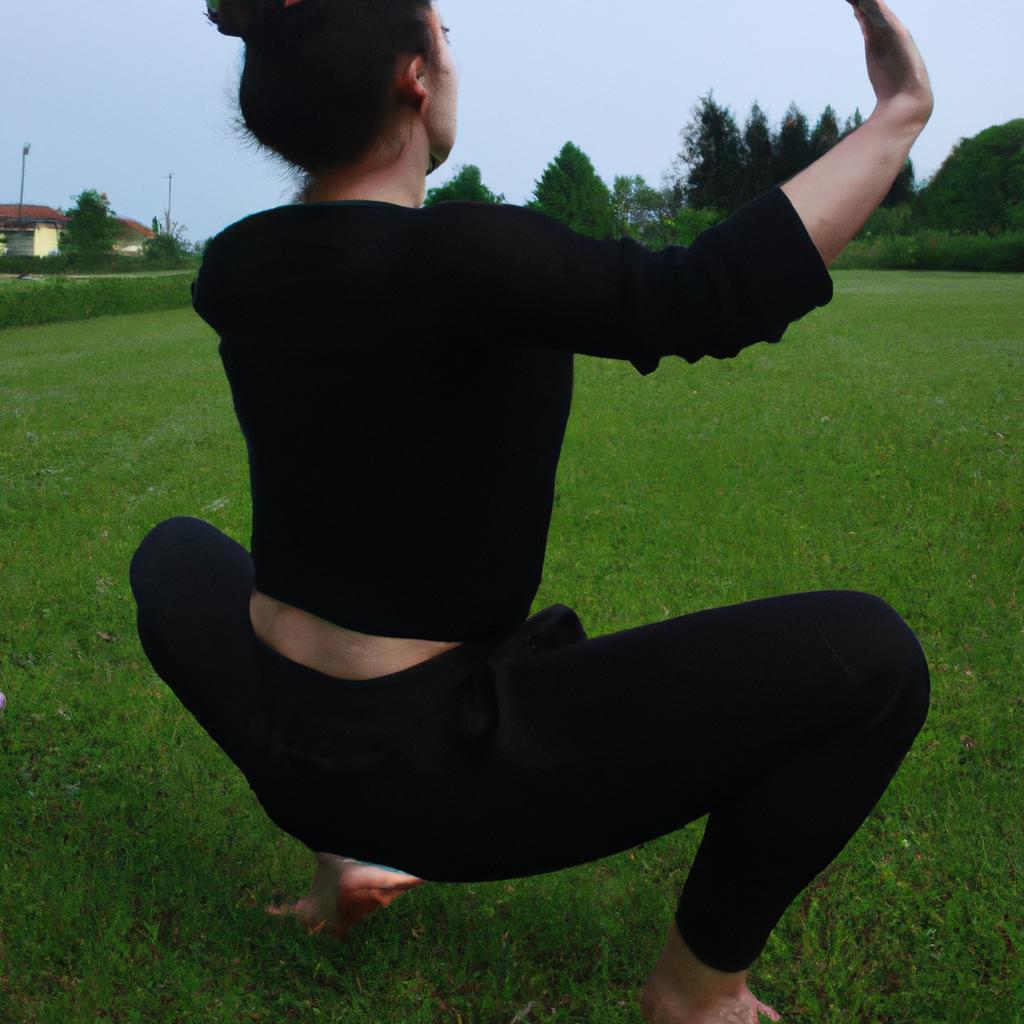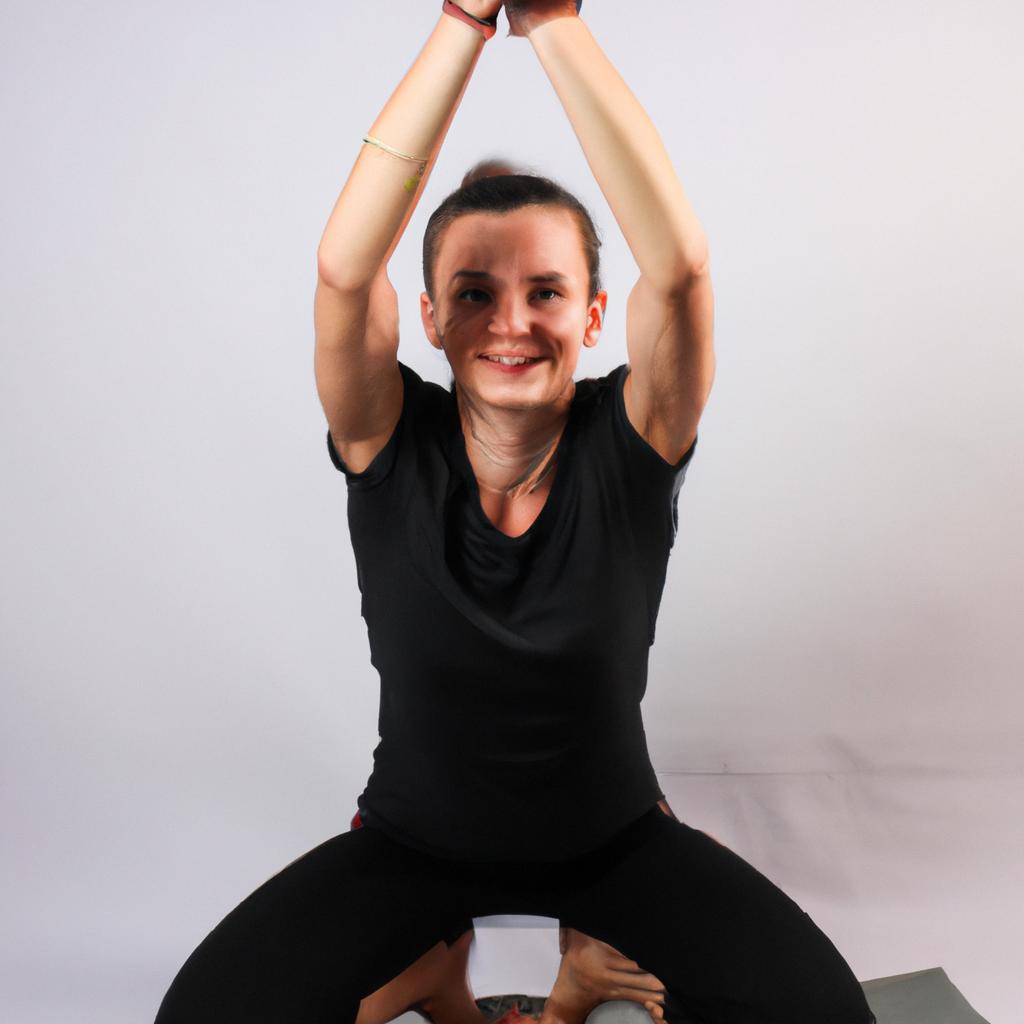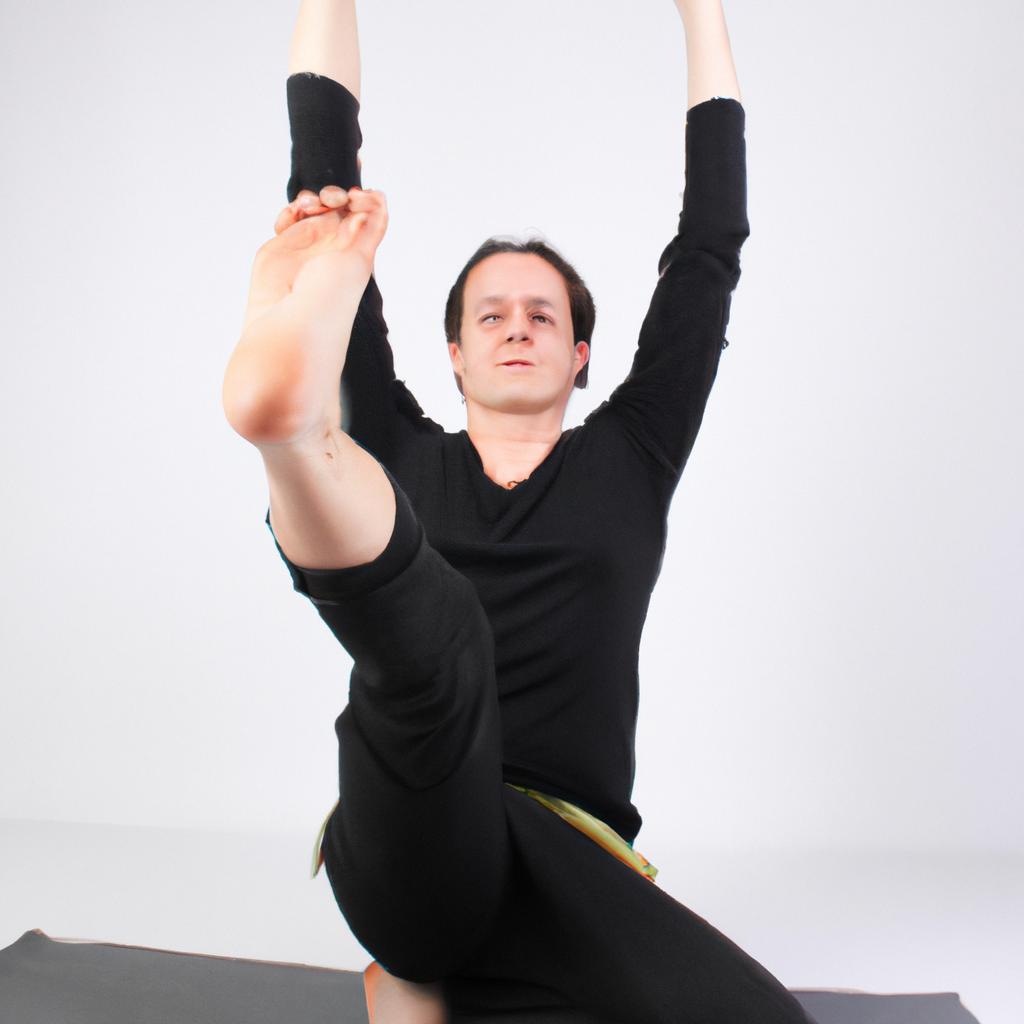Yoga has emerged as a popular practice for stress relief in recent years, offering individuals an opportunity to find solace amidst the chaos of modern living. This article aims to shine a spotlight on fitness studios that specialize in providing yoga classes specifically designed to alleviate stress and promote overall well-being. By exploring one particular case study, we will delve into the unique approach taken by these studios, shedding light on their techniques and philosophies.
Imagine a scenario where an individual finds themselves consumed by work-related pressures, feeling overwhelmed and unable to cope with the daily demands placed upon them. In search of respite from this perpetual state of stress, they stumble upon a local fitness studio offering specialized yoga classes tailored for stress relief. Intrigued by the prospect of finding inner peace through physical movement and breath control, they decide to give it a try. Little do they know that this decision would mark the beginning of not only their journey towards reducing stress but also transforming their entire perspective on life itself.
Through examining various fitness studios that prioritize stress-relief-oriented yoga practices, we can gain valuable insights into how such establishments cultivate environments conducive to relaxation and personal growth. Delving deeper into their methodologies and understanding the underlying principles behind their approaches will enable us to appreciate how yoga serves as a powerful tool for stress relief and overall well-being.
One of the key aspects that sets these specialized yoga studios apart is their emphasis on creating a calming and nurturing atmosphere. From the moment individuals walk through the doors, they are greeted by soothing music, soft lighting, and a warm ambiance that immediately puts them at ease. The studios are designed to be tranquil sanctuaries, free from distractions and outside influences, allowing participants to fully immerse themselves in their practice.
In terms of class structure, these studios often offer a variety of yoga styles that specifically target stress reduction. Gentle flow classes focus on slow, deliberate movements synchronized with breathwork to promote relaxation and release tension. Restorative yoga classes utilize supportive props like bolsters and blankets to facilitate deep relaxation and rejuvenation. Breathwork sessions teach individuals various breathing techniques aimed at calming the nervous system and reducing anxiety.
Beyond physical practice, these studios also incorporate elements of mindfulness into their teachings. Mindfulness meditation is often integrated into yoga classes or offered as standalone sessions. Participants are guided to bring their attention to the present moment, cultivating awareness without judgment. This practice helps individuals develop resilience against stressors by fostering a sense of inner peace and acceptance.
Furthermore, these specialized studios place an emphasis on individualized instruction and support. Teachers take the time to understand each participant’s unique needs and tailor their guidance accordingly. They provide modifications for different skill levels or physical limitations, ensuring that everyone can participate comfortably. Additionally, teachers may offer personalized advice on incorporating stress-relief techniques into daily life outside of the studio.
Overall, fitness studios specializing in stress-relief-oriented yoga create an environment where individuals can escape from the pressures of everyday life and find solace within themselves. By combining gentle physical movement with mindfulness practices and personalized instruction, they empower participants to take charge of their well-being and cultivate resilience in the face of stress. As more people recognize the profound benefits of this approach, it is likely that these specialized studios will continue to thrive and provide much-needed support for individuals seeking relief from the stress of modern living.
The Benefits of Mind-Body Connection
Imagine a person named Sarah who has been dealing with chronic stress for months. She constantly feels overwhelmed, anxious, and unable to relax. Desperate to find relief, she decides to try yoga as a means of managing her stress levels. Little did she know that this ancient practice would not only provide her with physical exercise but also offer profound benefits for her mind and emotional well-being.
One key benefit of practicing yoga is its ability to foster the mind-body connection. Through various postures (asanas) and breathing exercises (pranayama), individuals are encouraged to be fully present in the moment, focusing on their breath and sensations in their bodies. This heightened awareness allows practitioners like Sarah to tune into their thoughts and emotions, fostering self-reflection and introspection.
The mind-body connection cultivated through yoga offers numerous advantages for mental health and overall well-being:
- Increased self-awareness: Yoga helps individuals become more attuned to their own needs, desires, and boundaries.
- Stress reduction: By engaging in mindful movement and deep breathing techniques, people can activate the body’s relaxation response, reducing anxiety and promoting calmness.
- Emotional regulation: Regular yoga practice has been shown to enhance emotional resilience, allowing individuals to manage difficult emotions more effectively.
- Improved focus and concentration: The mindfulness aspect of yoga trains the brain’s attentional control mechanisms, enhancing cognitive function.
To further illustrate these benefits, consider the following table showcasing how regular yoga practice positively impacts different aspects of mental health:
| Mental Health Benefit | Description |
|---|---|
| Reduced symptoms of depression | Studies have found that practicing yoga can alleviate depressive symptoms by increasing serotonin levels and promoting feelings of well-being. |
| Enhanced mood stability | Consistent participation in yoga has been linked to improved mood regulation due to increased self-awareness and emotional balance. |
| Decreased anxiety levels | Research suggests that yoga lowers anxiety levels by activating the parasympathetic nervous system, which induces relaxation and reduces stress hormones. |
| Improved sleep quality | The practice of yoga has been associated with better sleep patterns, including increased total sleep time and reduced instances of insomnia. |
In light of these benefits, it is evident that cultivating a strong mind-body connection through yoga can have a profound impact on an individual’s overall well-being.
By exploring how stress affects the body, we can gain insight into why practices like yoga are essential for managing its detrimental effects.
Understanding the Impact of Stress on the Body
The Impact of Stress on the Body: A Deeper Understanding
Imagine a woman named Sarah, who is in her mid-thirties and works at a high-pressure corporate job. She constantly finds herself overwhelmed with deadlines, meetings, and demanding clients. As days turn into weeks, Sarah begins experiencing physical symptoms like headaches, muscle tension, and difficulty sleeping. These manifestations are not mere coincidences; they are direct consequences of chronic stress.
Stress has profound effects on our bodies, both physically and mentally. It triggers a cascade of physiological responses that can disrupt various systems within us. Let’s delve deeper into this understanding:
1. Immune System: Prolonged exposure to stress hormones weakens the immune system over time, making individuals more susceptible to illnesses such as colds or infections.
2. Cardiovascular System: Chronic stress increases blood pressure levels and contributes to the development of cardiovascular diseases like hypertension or heart disease.
3. Digestive System: Stress can lead to digestive issues such as stomach ulcers, irritable bowel syndrome (IBS), or appetite changes.
4. Mental Health: Anxiety disorders and depression often go hand-in-hand with chronic stress due to imbalances in neurotransmitters responsible for regulating mood.
To visually illustrate how different body systems are affected by stress, let’s take a look at the following table:
| Body System | Effects of Stress |
|---|---|
| Immune | Increased vulnerability to illness |
| Cardiovascular | High blood pressure, increased risk of heart disease |
| Digestive | Stomach ulcers, IBS-like symptoms |
| Mental | Anxiety disorders, depressive symptoms |
As we can see from both the case study example and the bullet point list above, unchecked stress can wreak havoc on our overall well-being. Recognizing these impacts is crucial because it allows us to appreciate the importance of managing stress effectively.
In the upcoming section, we will explore different yoga styles that can be instrumental in alleviating stress and promoting a healthier mind-body connection. By incorporating these practices into our lives, we can strive towards achieving balance and inner peace amidst life’s daily challenges.
Exploring Different Yoga Styles
Imagine a person named Sarah who leads a hectic lifestyle, juggling multiple responsibilities and constantly feeling overwhelmed. She often experiences physical symptoms like headaches, muscle tension, and difficulty sleeping due to stress. This scenario is all too familiar for many individuals in today’s fast-paced world. Stress can have profound effects on our bodies, both physically and mentally.
To comprehend how stress affects the body, it is essential to understand its physiological mechanisms. When faced with a stressful situation, such as an impending deadline or a conflict at work, the body releases hormones like cortisol and adrenaline. These chemicals prepare us for a fight-or-flight response by increasing heart rate, blood pressure, and glucose levels. While this reaction can be beneficial in short bursts, chronic stress exposes the body to prolonged periods of heightened arousal that can lead to various health issues.
The impact of long-term stress on the body cannot be underestimated. Here are some key consequences associated with chronic stress:
- Weakened immune system: Prolonged exposure to high levels of cortisol weakens the immune system over time, making individuals more susceptible to infections and illnesses.
- Cardiovascular problems: Elevated blood pressure caused by chronic stress increases the risk of developing cardiovascular diseases such as hypertension and heart attacks.
- Digestive disorders: Stress can disrupt digestive processes leading to conditions like irritable bowel syndrome (IBS) or acid reflux.
- Mental health concerns: Chronic stress has been linked to mental health disorders such as anxiety and depression.
| Consequences of Chronic Stress |
|---|
| Weakened immune system |
| Cardiovascular problems |
| Digestive disorders |
| Mental health concerns |
In summary, understanding how stress impacts our bodies is crucial for managing its negative effects effectively. Recognizing the signs and symptoms allows individuals to take proactive steps towards reducing their overall stress levels.
Transitioning into the subsequent section about “Finding the Right Fitness Studio for You,” it is important to explore various avenues where individuals can engage in stress-relieving activities. By considering factors such as location, class schedules, and instructor qualifications, one can make an informed decision when selecting a fitness studio that suits their needs best.
Finding the Right Fitness Studio for You
Having gained insight into various yoga styles and their unique benefits, it is now essential to find a fitness studio that aligns with your preferences and goals. By choosing the right fitness studio, you can ensure an environment conducive to stress relief while enjoying the many physical and mental advantages of practicing yoga.
To illustrate the importance of finding a suitable fitness studio, let’s consider Sarah’s experience. Sarah recently began her journey towards stress relief through yoga. She discovered that she prefers a slower-paced style like Yin Yoga, which allows her to hold poses longer and focus on deep stretching. However, when Sarah initially joined a high-intensity Vinyasa Flow class at a local gym, she found herself feeling overwhelmed rather than relaxed. This example highlights how selecting the appropriate fitness studio plays a crucial role in maximizing the positive effects of yoga practice.
When searching for a fitness studio that caters to stress relief through yoga, keep these key considerations in mind:
-
Atmosphere and Ambience:
- Serene surroundings can enhance relaxation.
- Choose studios with calming decor or nature-inspired elements.
- Look for spaces offering natural light or dimmed lighting during sessions.
- Opt for locations away from busy streets or noisy environments.
-
Class Offerings:
- Seek studios specializing in stress-relief-oriented classes such as Restorative Yoga or Gentle Hatha.
- Look for additional features like meditation sessions or workshops focusing on mindfulness techniques.
- Ensure schedules provide flexibility to accommodate your availability.
-
Instructor Expertise:
- Research instructors’ qualifications and certifications related to stress management and relaxation techniques.
- Read reviews or seek recommendations to gauge their teaching style and ability to create a soothing environment.
- Find out if instructors offer modifications for different levels of experience or physical limitations.
-
Community and Support:
- Join a studio that fosters a welcoming and inclusive community.
- Consider studios organizing events or social gatherings to foster connections among practitioners.
- Seek spaces where you feel supported, both by the instructors and fellow yogis.
By carefully considering these factors when selecting a fitness studio, you can create an optimal foundation for your stress relief journey through yoga. Remember, finding the right fit is crucial in ensuring a positive and rewarding experience.
Transition into the subsequent section:
As we delve deeper into exploring various aspects of yoga for stress relief, let us now turn our attention towards the significant role breathing techniques play in enhancing relaxation and promoting overall well-being.
The Role of Breathing Techniques in Stress Relief
Having explored how to find the right fitness studio that suits your needs, let us now delve into the role of breathing techniques in stress relief. Understanding and practicing proper breathing techniques can significantly contribute to reducing stress levels and promoting overall well-being.
Breathing exercises are an integral part of yoga practice. Let’s consider a hypothetical example to better illustrate their impact on stress relief. Imagine Sarah, a busy professional constantly overwhelmed by work-related pressures. She attends regular yoga classes at her local fitness studio where she learns various breathing techniques. By incorporating these practices into her daily routine, Sarah experiences increased calmness, reduced anxiety, and improved focus both during her yoga sessions and throughout her day-to-day life.
To fully appreciate the benefits of breathwork for stress relief, it is important to understand its physiological effects on our bodies. The following bullet point list highlights some key ways in which breathing techniques positively impact our well-being:
- Deepens relaxation response
- Reduces heart rate and blood pressure
- Increases oxygen flow to the brain
- Activates the parasympathetic nervous system
In addition to these physiological effects, there are also numerous mental and emotional benefits associated with incorporating breathing techniques into one’s lifestyle. Consider the following table outlining these aspects:
| Mental Benefits | Emotional Benefits |
|---|---|
| Enhanced concentration | Reduced anxiety |
| Improved clarity | Increased self-awareness |
| Heightened mindfulness | Better emotional control |
By regularly practicing proper breathing techniques as part of a yoga routine or even independently, individuals can unlock these positive outcomes within themselves.
Understanding the significance of breathing techniques in stress relief sets the stage for exploring another essential aspect of yoga practice: incorporating meditation. By seamlessly transitioning from breathwork to meditation, individuals can further enhance their stress management skills and cultivate a deeper state of relaxation.
Incorporating Meditation into Your Yoga Practice
Transitioning from the previous section discussing breathing techniques, let us now explore how to incorporate meditation into your yoga practice. Meditation is a powerful tool that can further enhance stress relief benefits in yoga. By integrating mindfulness and focused attention, meditation helps calm the mind, reduce anxiety, and promote overall well-being.
To illustrate the impact of incorporating meditation into yoga for stress relief, consider this hypothetical example: Sarah, an individual experiencing high levels of work-related stress, decides to try yoga as a way to find balance and relaxation. Initially, she focuses solely on physical postures (asanas) but soon realizes that combining these poses with meditation brings about profound positive changes in her mental state.
When it comes to incorporating meditation into your yoga practice for stress relief, there are several key considerations:
- Set aside dedicated time: Allocate specific periods during each yoga session solely for meditation. This allows you to focus completely on cultivating inner stillness and tranquility.
- Choose a comfortable posture: Find a seated position that feels stable yet relaxed for extended periods without causing discomfort or strain.
- Begin with guided meditations: Especially if you are new to meditation, using audio recordings or apps that provide guided meditations can be helpful in establishing a regular practice.
- Gradually increase duration: Start with shorter durations of 5-10 minutes and gradually extend them over time as you become more comfortable and adept at quieting the mind.
By incorporating mindful meditation into your yoga practice regularly, you can experience numerous benefits like improved mental clarity, reduced stress levels, enhanced emotional well-being, and increased self-awareness.
| Benefits of Incorporating Meditation |
|---|
| Enhanced focus |
| Increased self-awareness |
| Stress reduction |
In summary, by embracing the integration of meditation within your yoga routine for stress relief, you can tap into the profound benefits of cultivating mindfulness and focused attention. Set aside dedicated time for meditation, adopt a comfortable posture, consider guided meditations initially, and gradually increase duration. By doing so, you enhance your overall well-being and experience the transformative effects that yoga combined with meditation can have on reducing stress levels.
Note: The following section will discuss nutrition tips to complement your yoga practice for stress relief.




